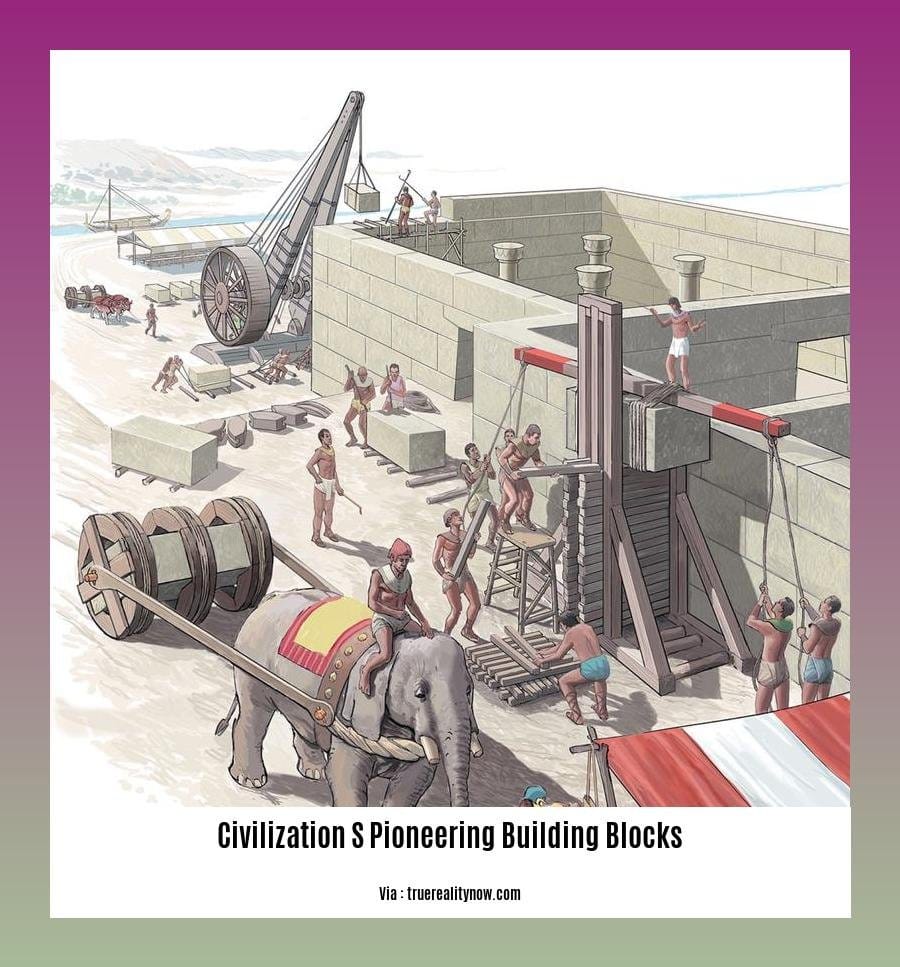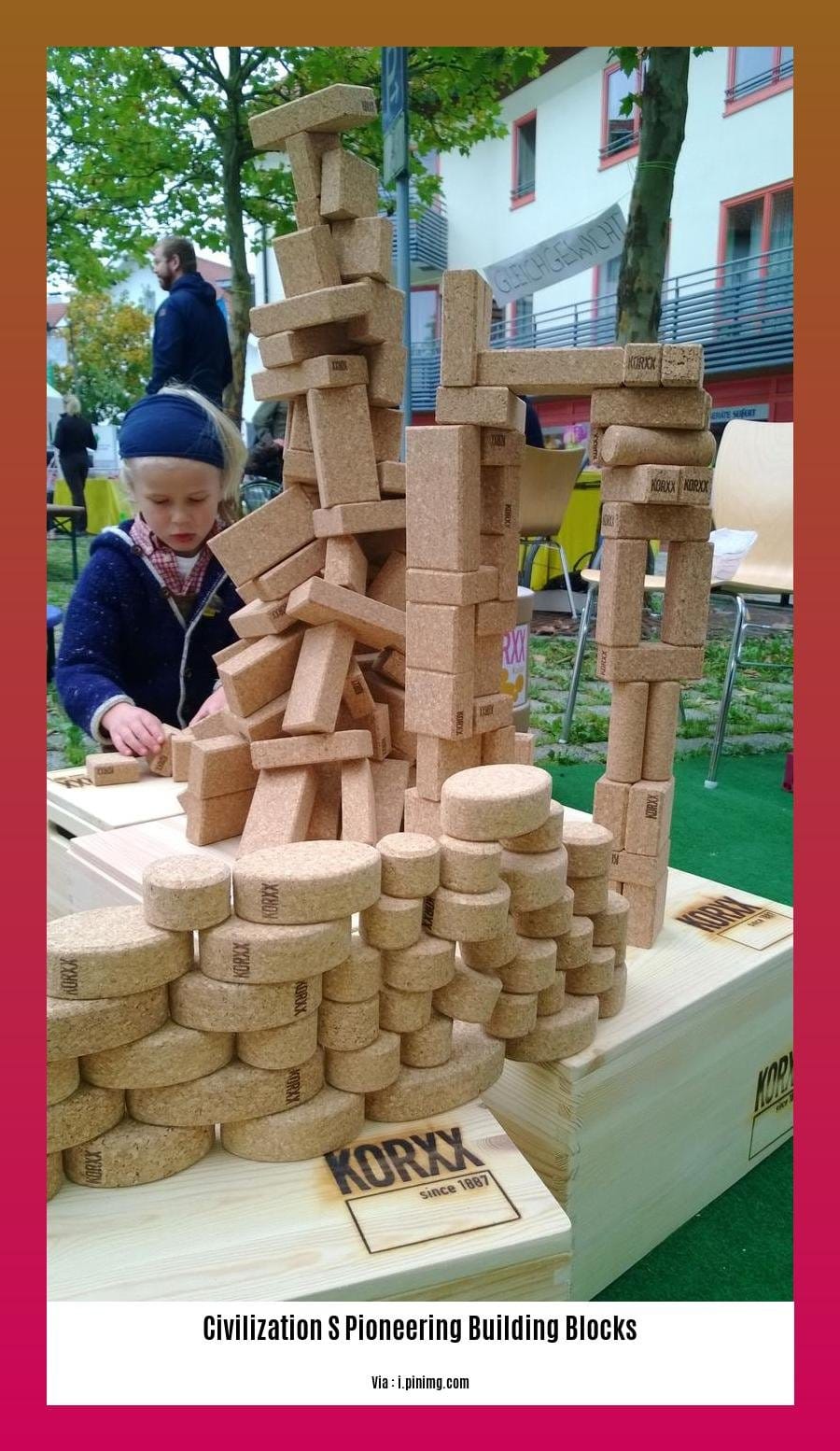Unveiling the secrets of ancient civilizations’ ingenuity, “Civilization’s Pioneering Building Blocks: A Journey into Ancient Ingenuity” explores the remarkable architectural innovations and technological advancements that shaped our modern world.

Key Takeaways:
- Cities were the foundational elements of civilizations.
- Mesopotamia was instrumental in human progress and innovation.
- Brick has been a widely used construction material throughout history.
- Augusta McMahon’s research sheds light on early Mesopotamian urban dynamics.
Unraveling the Civilization’s Pioneering Building Blocks
In the dawn of civilization, building blocks were more than just materials; they were instruments of progress. From the humble beginnings of mud huts to the towering pyramids and sprawling cities, these blocks shaped the very foundation of human society. Let’s delve into their journey:
Natural Materials: A Foundation Laid in Nature
Civilizations, like mighty oaks, rooted themselves in natural resources. Stone, wood, and clay became their faithful companions, providing shelter and shaping their built environment. Stone, with its enduring strength, formed the pillars of temples and palaces. Wood, versatile and flexible, crafted sturdy houses and ingenious tools. Clay, malleable and fire-resistant, molded into bricks that built the walls of thriving cities.
Manufactured Materials: Innovation’s Ingenious Leap
As civilizations advanced, so too did their building prowess. They mastered the art of crafting manufactured materials, expanding their architectural horizons. Brick, a testament to human ingenuity, replaced its natural counterpart, offering greater durability and standardized construction. Concrete, a revolutionary blend of stone and lime, revolutionized engineering, paving the way for grand structures that defied gravity itself. Steel, the epitome of strength and resilience, became the backbone of modern skyscrapers, reaching for the heavens.
Technological Advancements: Pushing the Limits of Construction
Creativity and innovation went hand in hand with the development of civilization’s pioneering building blocks. The invention of the wheel eased transportation, enabling the movement of heavy materials. Cranes and scaffolding, ingenious feats of engineering, allowed civilizations to build higher and bolder. Advanced tools like the saw and chisel transformed wood and stone into intricate works of art, adorning buildings with exquisite details.
Civilization’s Pioneering Building Blocks: From Humble Origins to Enduring Legacies
These building blocks were more than mere materials; they were the cornerstones of human progress, enabling civilizations to thrive. They not only protected and housed but also fostered creativity, inspired innovation, and left an indelible mark on the world’s architectural landscape. From ancient ruins to modern marvels, their legacy continues to inspire and remind us of the enduring power of human ingenuity.
Let us explore how the pioneers who laid foundations of modern civilization envisioned the pioneering pillars upon which modernity stands. Their legacy is evident in the forefathers whose innovations shaped modern world.
Technological Advancements in Building Blocks
Throughout history, technological advancements in building blocks have laid the foundation for the rise of civilizations. From the earliest shelters to the grandest cathedrals, the materials and methods used in construction have shaped the built environment and enabled human ingenuity to flourish.
Natural Materials
In ancient times, civilizations relied on natural materials such as stone, wood, and clay to build structures. These materials were readily available, durable, and required minimal processing. Stone was used for pyramids, temples, and fortifications, while wood was used for framing, roofing, and furniture. Clay was employed to create bricks, tiles, and pottery.
Manufactured Materials
As civilizations advanced, they developed new manufactured materials that expanded architectural possibilities. Brick-making techniques improved, and bricks became a common building material for houses, walls, and bridges. Concrete, invented by the Romans, revolutionized construction by providing a strong and durable material that could be poured into molds. Steel, introduced in the 19th century, enabled the construction of skyscrapers and other tall structures.
Technological Advancements
Technological advancements have played a crucial role in the development of new building blocks and improved construction methods. The invention of the wheel facilitated the transportation of heavy materials, while cranes and scaffolding allowed for the construction of taller and more complex structures. Tools such as saws, hammers, and drills helped to shape and assemble building blocks with precision.
Key Takeaways:
- The use of natural materials, such as stone, wood, and clay, laid the foundation for early civilizations.
- Manufactured materials, such as brick, concrete, and steel, expanded architectural capabilities.
- Technological advancements, such as the wheel, cranes, and tools, facilitated construction and intricate designs.
[Relevant Source]:
Building Blocks and Construction of Essential Structures
Building blocks are the foundation of civilization. They are the materials we use to construct our homes, temples, and fortifications – the essential structures that allow us to live, work, and thrive.
Throughout history, humans have used a variety of building blocks, from natural materials like stone and wood to manufactured materials like brick and steel. Each material has its own unique properties and advantages, and the choice of which material to use depends on a variety of factors, including the availability of materials, the climate, and the desired style of the building.
Natural materials were the first building blocks used by humans. Stone was used to build the pyramids of Egypt, the temples of Greece, and the castles of medieval Europe. Wood was used to build the houses of the Vikings, the ships of the Chinese, and the churches of the American colonies. Clay was used to build the walls of the city of Jericho, the houses of the ancient Romans, and the pottery of the Native Americans.
Manufactured materials are a more recent invention, but they have quickly become the most popular building blocks used in the world today. Brick was first invented in Mesopotamia in the 3rd millennium BC, and it has been used ever since to build houses, walls, and other structures. Concrete was invented in the Roman Empire in the 1st century BC, and it is now used to build everything from bridges to skyscrapers. Steel was invented in the 19th century, and it is now used to build ships, cars, and buildings.
The construction of essential structures has changed dramatically over time. In the past, buildings were constructed by hand, using simple tools and techniques. Today, buildings are constructed using heavy machinery and advanced engineering techniques. This has made it possible to build larger and more complex structures than ever before.
The building blocks and construction techniques that we use today are the result of centuries of innovation and development. They are a testament to the human spirit of creativity and ingenuity.
Key Takeaways:
- Building blocks are the foundation of civilization.
- Humans have used a variety of building blocks throughout history, from natural materials like stone and wood to manufactured materials like brick and steel.
- The construction of essential structures has changed dramatically over time, thanks to advances in technology and engineering.
Most Relevant URL Source:
- Early Years of Concrete Block: A Brief History of Architectural Concrete
Legacy of building blocks in the built environment
Natural Resources, Manufactured Materials, and Technological Advancements: The Cornerstones of Civilization
Our ancestors weren’t just stacking rocks and piling up dirt. They were laying the foundations of civilization with every brick, every timber, and every slab of concrete. Natural resources like stone, wood, and clay gave us shelter and structure. Manufactured materials like brick, concrete, and steel expanded our architectural horizons. But it was the technological advancements – the invention of the wheel, cranes, and tools – that allowed us to turn these humble materials into awe-inspiring structures.
The Great Pyramids of Giza, the Colosseum in Rome, and the skyscrapers of New York City – these architectural marvels wouldn’t exist without the ingenuity of our ancestors. They used the legacy of building blocks to create structures that not only served practical purposes but also showcased their creativity and innovation. These structures tell the story of human progress, from the humble beginnings of cave dwellings to the towering heights of modern architecture.
The legacy of building blocks is not just about the physical structures we see around us. It’s about the knowledge and skills that were passed down from generation to generation, enabling us to build bigger, better, and more sustainable structures. It’s about the human spirit of innovation and the desire to create something that will last.
Key Takeaways:
- Building blocks have been the foundation of civilization, enabling the construction of essential structures like shelters, temples, and fortifications.
- Natural resources like stone, wood, and clay were the earliest building materials, while manufactured materials like brick, concrete, and steel expanded architectural capabilities.
- Technological advancements such as the wheel, cranes, and tools facilitated the construction of more intricate and durable structures.
- Building blocks have played a crucial role in societal progress, enabling the development of cities, trade, and cultural exchange.
- The legacy of building blocks continues to inspire modern architecture and construction, with new materials and techniques constantly being developed.
Source: The Building Blocks of Civilization

FAQ
Q1: What materials were commonly used in ancient civilizations for building structures?
Q2: Which ancient civilizations made significant contributions to the development of building techniques and materials?
Q3: How did the use of bricks evolve from ancient times to the present day?
Q4: What were some of the key innovations in brick-making technology during the Industrial Era?
Q5: What factors led to the decline in the use of bricks in the 20th century?
- Unlocking 2-Letter Words with U: The Definitive Guide - April 4, 2025
- Unlock Words with the Letters THREE: Top Unscramble Tools 2025 - April 4, 2025
- Master Scrabble: X & Z Words for High Scores - April 4, 2025
















